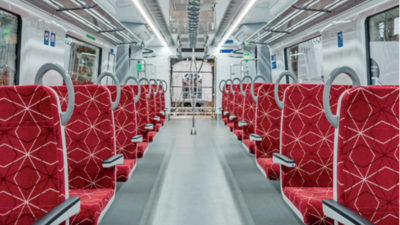Top Searches
- News
- City News
- delhi News
- Use mobile app to find your way on Delhi-Meerut RRTS, watch movies on the go
Use mobile app to find your way on Delhi-Meerut RRTS, watch movies on the go

Commuters, standing at one spot in the RRTS station, will be able to find their way in and around the RRTS station by scanning the nearest marker and pointing the app in the guided direction.
NEW DELHI: When the Delhi-Meerut Regional Rapid Transit System (RRTS) corridor becomes operational in a few years, commuters would just need to open their smartphone’s camera to locate a station’s entry or exit point, elevators, platforms, toilets, shops or nearby bus and e-rickshaw stands.
Thanks to augmented reality (AR), virtual arrows will show people their destination on their smartphone screens.

“NCRTC (National Capital Region Transport Corporation) is developing a state-of-the-art augmented reality navigation tool for commuters to explore the RRTS system. This tool will help commuters find their way inside a station on the Delhi-Ghaziabad-Meerut corridor,” an NCRTC spokesperson said on Tuesday.
He said the navigation tool would offer real-time guidance through 3D and 2D maps of the premises. Commuters can access this facility through the NCRTC app to search for a public utility or facility on the premises. “The commuter can follow the directions shown on the camera view of a smartphone to navigate more naturally across RRTS stations,” the spokesperson said.
Commuters, standing at one spot in the RRTS station, will be able to find their way in and around the RRTS station by scanning the nearest marker and pointing the app in the guided direction. As soon as the user selects the destination, virtual arrows on the screen appear and the user simply has to follow them to reach the destination. The application also includes virtual avatars that will greet commuters with a traditional namaste and guide them.
“From platforms to utilities like shops inside the RRTS station to the parking lot, nearest attractions and other public modes of transport nearby, this app will lead the way while also showing the other amenities on the way,” the spokesperson said.
NCRTC is trying to develop a user-friendly and feature-heavy mobile application that will have more features than just the AR tool. For instance, commuters might be able to watch films or a web series on OTT platforms for free.
According to officials, the application is likely to have an entertainment section, which will display several media options for users. The content is likely to be made available either through integration to an OTT platform or would be provided on a server. The cost of subscription of the OTT platform will be borne by NCRTC, according to the yet-to-be-finalised plan.
Apart from the usual features of any public transit application like train timings, real-time location, estimated time of arrival, closest station, etc., the NCRTC application will also have features like 'trusted people notification' and SOS calls, finding feeder or cab service from selected station, food pre-order service and online shopping from shops at stations. The application will also aid the user in buying tickets, QR ticketing or smartcard recharge.
The navigation tool can be accessed by a smartphone or webpage. This will also be incorporated into the NCRTC App being developed for commuters.
The spokesperson said that the user interface and experience of the navigation tool have been kept simple and it is designed to be used on a smartphone employing just one hand. “The main navigation section will have all the control buttons at the bottom so that users can use the facility single-handedly and with ease while travelling on the RRTS network,” he said.
Thanks to augmented reality (AR), virtual arrows will show people their destination on their smartphone screens.

“NCRTC (National Capital Region Transport Corporation) is developing a state-of-the-art augmented reality navigation tool for commuters to explore the RRTS system. This tool will help commuters find their way inside a station on the Delhi-Ghaziabad-Meerut corridor,” an NCRTC spokesperson said on Tuesday.
He said the navigation tool would offer real-time guidance through 3D and 2D maps of the premises. Commuters can access this facility through the NCRTC app to search for a public utility or facility on the premises. “The commuter can follow the directions shown on the camera view of a smartphone to navigate more naturally across RRTS stations,” the spokesperson said.
Commuters, standing at one spot in the RRTS station, will be able to find their way in and around the RRTS station by scanning the nearest marker and pointing the app in the guided direction. As soon as the user selects the destination, virtual arrows on the screen appear and the user simply has to follow them to reach the destination. The application also includes virtual avatars that will greet commuters with a traditional namaste and guide them.
“From platforms to utilities like shops inside the RRTS station to the parking lot, nearest attractions and other public modes of transport nearby, this app will lead the way while also showing the other amenities on the way,” the spokesperson said.
NCRTC is trying to develop a user-friendly and feature-heavy mobile application that will have more features than just the AR tool. For instance, commuters might be able to watch films or a web series on OTT platforms for free.
According to officials, the application is likely to have an entertainment section, which will display several media options for users. The content is likely to be made available either through integration to an OTT platform or would be provided on a server. The cost of subscription of the OTT platform will be borne by NCRTC, according to the yet-to-be-finalised plan.
Apart from the usual features of any public transit application like train timings, real-time location, estimated time of arrival, closest station, etc., the NCRTC application will also have features like 'trusted people notification' and SOS calls, finding feeder or cab service from selected station, food pre-order service and online shopping from shops at stations. The application will also aid the user in buying tickets, QR ticketing or smartcard recharge.
The navigation tool can be accessed by a smartphone or webpage. This will also be incorporated into the NCRTC App being developed for commuters.
The spokesperson said that the user interface and experience of the navigation tool have been kept simple and it is designed to be used on a smartphone employing just one hand. “The main navigation section will have all the control buttons at the bottom so that users can use the facility single-handedly and with ease while travelling on the RRTS network,” he said.
FOLLOW US ON SOCIAL MEDIA
FacebookTwitterInstagramKOO APPYOUTUBE
Start a Conversation
end of article










